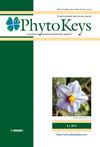墨西哥 Uxpanapa 地区的两种叶片成簇的 Ocotea(月桂科)新种。
IF 1.3
3区 生物学
Q3 PLANT SCIENCES
引用次数: 0
摘要
描述了产于墨西哥南部的两新种(樟科)。根据它们的花形态、营养成分和微形态特征,这两个物种都被限定在Ocoteahelicterifolia组。在这个分支中,这两个物种在形态上与那些具有簇状叶子的物种相似。这两个物种都是墨西哥乌斯帕纳帕地区物种丰富但支离破碎的森林的特有物种,因此,它们的种群受到威胁。本文讨论了两种植物的形态相似性及其保护现状。本文章由计算机程序翻译,如有差异,请以英文原文为准。
Two new species of Ocotea (Lauraceae) with clustered leaves from the Uxpanapa region, Mexico.
Two new species of Ocotea (Lauraceae) from Southern Mexico are described and illustrated. Based on their floral morphology, vegetative indument, and micromorphological attributes, both species are circumscribed within the Ocoteahelicterifolia group. Within this clade, the two species are morphologically similar to those with clustered leaves. Both species are endemic to the species-rich yet fragmented forests of the Uxpanapa region in Mexico, and therefore, their populations are threatened. Here, the morphological similarities of both species and their conservation status are discussed.
求助全文
通过发布文献求助,成功后即可免费获取论文全文。
去求助
来源期刊

PhytoKeys
PLANT SCIENCES-
CiteScore
2.60
自引率
14.30%
发文量
189
审稿时长
6 weeks
期刊介绍:
PhytoKeys is a peer-reviewed, open-access, online and print, rapidly produced journal launched to support free exchange of ideas and information in systematic botany.
All papers published in PhytoKeys can be freely copied, downloaded, printed and distributed at no charge for the reader. Authors are thus encouraged to post the pdf files of published papers on their homepages or elsewhere to expedite distribution. There is no charge for color.
 求助内容:
求助内容: 应助结果提醒方式:
应助结果提醒方式:


